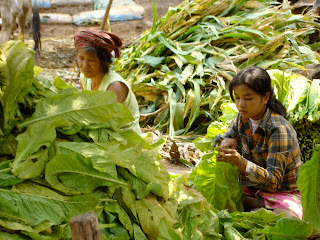So even volunteers learning a new language get a day off and we took the opportunity to go on a tuk-tuk ride across the Mekong river to the island for the day. It was great to break the routine and the small habitat I've created for myself which involves a circuit from the hotel (above as viewed from the Kizuna Bridge), various cafes and the cycle ride to University Western. Gideon the tuk-tuk driver had devised a $6 day out to one of only 2 wooden pagodas left in Cambodia.
Every where is very dusty and dry at the moment, the farmers of Cambodia wait for the rains and the island we visited will be mostly submerged by the rising waters of the Mekong. Not sure the Dam above will stop the rising tide though.
Ground nuts get a measly 500 Riel for 1 kg, a lot of hot work for the middle men to make all the money. That's the kind of issues that VSO livelihood projects are here to address. Louise (above) always ready to pop up unexpectedly in anyone's photo.
The plants in the foreground are tapioca and there was plenty of maize, chillies, cucumbers growing but paddy fields are empty for now as they need the rain to start the Bai season. Where my placement is in Battambang is known as the rice bowl of Cambodia, so there will plenty of photo opportunities of paddy fields to follow.
This is the bridge that our 3 tuk-tuk's navigated. We got out and walked over which was a good thing as Gideon nearly skidded off the dirt track on the other side into the river. With the interesting 4 lane system in town, the large volume of 'moto's' on the road and the unsealed/potholed state of the roads I'm quite surprised my skills haven't been required so far.
We arrived at the wooden temple just in time for the monk's lunch. Neil was approached by one (above) who wanted to tell him all about his last 6 months since starting as a monk.
Gideon told us a story about a 'ghost' who lives in the temple that he has seen four times. He is 6 ft 5, black with a goatee and apparently dressed like me! He also told us that the wooden temple was used as a hospital during Pol Pot which is why it had been spared the fate of the rest.
This statue however was less fortunate.
 Peter from our group has lived in Bali for the last 20 years and instructed us on how to light some incense, find a nook or cranny to wedge it in and then say a prayer.
Peter from our group has lived in Bali for the last 20 years and instructed us on how to light some incense, find a nook or cranny to wedge it in and then say a prayer.There were plenty of Buddhas in the temple of all shapes, sizes and colours, but they are always smiling.
The decoration of the wooden ceiling and pillars was spectacular and my little cybershot does not do it justice.
The other big crop in this part of the world is tobacco which is picked, dried and cut by hand. You can be sure that the growers don't get much of a profit.
Another industry is cotton and silk weaving. Some of our group bought a cotton scarf AKA gror-maa from this woman for at least twice if not three times the price at market. When you see all the work and hours spent at the loom it seemed churlish to barter. Plus now I own the ubiquitous gror-maa, all things to all people.
The kids are all exceptionally gorgeous and I had to resist taking hundreds of photos all of which would have been similar to my justgiving page photo. Nannee however was particularly smiley and chatty in English and Khmer and that was even without the sweets some of the group had brought with them.
Diversifying in our modes of transport we got the boat over to the island. Sat on the roof of the boat going across the mighty Mekong cemented our resolve to go on a boat trip for the next rest day.
Our tuk-tuk convoy.....
After driving back to Kampong Cham over the Bamboo bridge AKA Spean Russey (see previous blog) having a long, cold milk shake and washing off the thick layer of dust encrusted everywhere, Lou and I sat out hemming our newly purchased scarfs. This kept us occupied for over an hour while the locals laughed at us and thought to themselves "Crazy barangs, don't they realise in the market there are plenty of tailors that would do that for them in 5 minutes for 75 cents?!"















Love the pictures xxxx
ReplyDelete